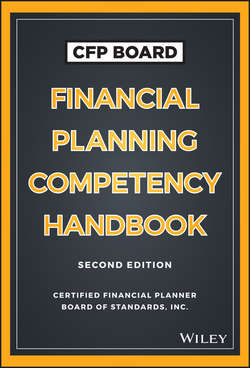Читать книгу CFP Board Financial Planning Competency Handbook - Board CFP - Страница 44
На сайте Литреса книга снята с продажи.
PART One
Introduction
CHAPTER 6
Financial Planning Process
IN PRACTICE
ОглавлениеProspective Client
Frequently a prospective financial planning client will be referred to a personal financial planner to solve an immediate, pressing need. This need may initially reside in only a single financial planning content area and may, at the moment, be the prospect’s sole focus. However, by closely following the financial planning process, the planner may uncover additional client planning gaps that need to be prioritized and addressed over time.
Consider the following case: In 1995, the prospect’s father passed away at the age of 73. Under the terms of the patriarch’s last will and pour-over trust, a charitable lead annuity trust (CLAT) was to be created and was designed to mitigate the impact of federal estate taxes in the father’s estate. Though married, the patriarch’s estate, at $5 million taxable, was considerably smaller than the estate of his surviving spouse. The prospect was designated as co-trustee of the CLAT. The family had worked for many years with the trust department (corporate co-trustee) of a super-regional banking institution; however, CLAT arrangements in estate planning were not as common in the early 1990s, and the professionals in the trust department were unfamiliar with how to administer and manage the trust. Since the trust would be funded with $2.7 million in investable assets, the family was most interested in working with a corporate trustee firm that had experience with more sophisticated transfer tax arrangements. Provision existed in the pour-over trust agreement for the resignation or removal of the designated corporate co-trustee and the appointment of a successor corporate co-trustee.
The initial meeting with the prospect entailed a probing process to understand specific family needs so that the prospect relationship could be established and properly defined. The personal financial planner employed by the prospective corporate trustee took pains to discuss the firm’s capabilities and services, with specific attention paid to the responsibilities to be assumed by the successor corporate co-trustee and those retained by the individual co-trustee. Since the prospective corporate co-trustee was one of three firms being considered by the family, a period of several weeks elapsed before the family concluded the interview and evaluation process.
Once the family had made a decision, appropriate legal steps were taken to have the firm of choice formally appointed as successor trustee. At this point, the financial planning process resumed with gathering client data and establishing goals for the CLAT. Since the purposes of the trust were to provide an annuity to a designated charity for a 20-year period followed by a distribution of the trust remainder to the patriarch’s three adult children, an extensive amount of information was collected from each branch of the family in order to design an efficient and effective investment plan. Once developed, the recommendations were presented for the family’s consideration and to obtain the individual co-trustee’s concurrence with the outlined strategy. The proposed investment plan was implemented, and the CLAT began to function as the patriarch had envisioned and directed under the terms of his pour-over trust agreement.
Based on confidential information collected during the client data-gathering process and during subsequent family meetings over several years, the personal financial planner identified additional financial planning issues where the family might benefit from an expanded engagement. The family concurred, and what initially started as a $2.7 million investment management relationship blossomed into a $40 million comprehensive engagement involving assessment of banking, credit, insurance, income tax, estate, and retirement planning needs.
Kariga
Kariga Lawrence is a new financial planning practitioner. He has been very active volunteering in local community service programs, as well as serving on several non-profit advisory boards. Kariga believes that these activities serve as a form of marketing, and he hopes his volunteer services will soon bring many new clients into his practice. Another innovative marketing approach used by Kariga involves paying a referral fee to anyone who refers clients to him. He also accepts payment from accountants, attorneys, and other professionals when he refers his own clients for services provided by others. During the initial client meeting, Kariga discusses his financial planning approach, attitudes regarding macroeconomic events, and views regarding the securities markets. He is diligent about providing a brochure and marketing material to clients. Because of his unique marketing procedures, he sometimes tells new clients that they can receive a referral fee. He never tells prospective or current clients about fees received when he refers his contacts to other professionals. Even though Kariga may feel that the way he is compensated is unrelated to the financial planning process, the fact that Kariga does not fully disclose his methods of compensation is a violation of the CFP Board of Standards, Inc. Standards of Professional Conduct. In effect, lack of disclosure at any step in the planning process can jeopardize the planner–client relationship and, in some situations, result in compliance complaints and sanctions.
